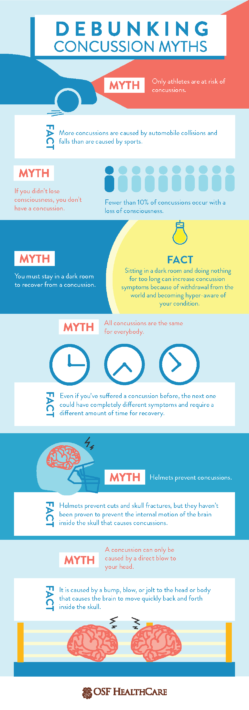
Myths about concussions increase the risk of harmful effects
Concussion awareness is on the rise as work progresses to understand the causes and effects. However, while research is shedding new light on concussions, and old assumptions are being re-evaluated, there are a lot of misconceptions out there.
We spoke with Jenna Ford, APN, who manages pediatric concussions for the OSF HealthCare Illinois Neurological Institute Concussion Clinic, to tackle the most common misconceptions and set the facts straight.
Myth: A concussion can only be caused by a direct blow to your head
A concussion is caused by rapid movement of the brain inside the skull. It can be caused by a blow to the head or by enough force applied to the chest, neck or any other part of the body.
“A lot of people think they’re fine because they didn’t hit their head, but things like motor vehicle crashes, falls in the home or being struck by an object can cause a concussion,” Ford said.
Myth: If you didn’t lose consciousness, you didn’t have a concussion
Only about 10 percent of concussions occur with a loss of consciousness. When there is a loss of consciousness, it is often brief, lasting for just a moment.
If someone has had a concussion, symptoms will begin to show within 24 hours of the injury.
“The symptoms can be subtle and written off as indicators of daily stress, so you need to be aware if you’ve had a physical event that could cause a chemical change that changes how the brain normally works,” Ford said.
Myth: All concussions are the same for everybody
Even if you’ve suffered a concussion before, the next one could have a completely different cause and symptoms and require a different amount of time and type of treatment for recovery. Every concussion is different, and most people recover within a few weeks after injury, with the first 10 days being the time of the greatest risk of repeat injury.
Myth: You must stay in a dark room to recover from a concussion
Concussion is not a one-size-fits-all condition and treatment is individualized for every unique case.
“You make somebody sit in a dark room with no screens or anything and they’re going to go crazy,” Ford said. “Generally, we advise two or three days to limit non-essential cognitive and physical demands that take away energy needed for brain healing.”
If symptoms are stable after that, you can start to gradually resume normal daily activities, initially avoiding activities that are heavily taxing or require prolonged focus. If symptoms worsen or return, decrease your activities and try again to increase your activities gradually.
Myth: Helmets prevent concussions
Helmets prevent cuts and skull fractures, but they haven’t been proven to prevent the internal motion of the brain inside the skull that causes concussions.
However, equipment should fit properly, be worn at all times, meet manufacturer standards and be inspected each season for proper fit to prevent injuries that may complicate and prolong your recovery from a concussion.
Myth: Only athletes are at risk of concussion
Data from the Centers for Disease Control show sports is not the number one cause of concussions. For the younger and older age groups, it’s falls within the home. For the ages in between, motor vehicle crashes, assault and being struck by an object are the top causes.
“A lot of concussions tend to go unrecognized because people associate concussions with sports and don’t think they could have suffered one,” Ford said.
Fact: If you show any signs of a concussion, you need to seek treatment.
We don’t yet have enough evidence to know what, when and how bad the long-term effects of concussions might be. What we know for sure is that we all only have one brain. You don’t want to risk permanent, irreversible damage.
The OSF INI Concussion Clinic has several advanced practice providers trained in concussion management. The team treats pediatrics, adolescents and adults. If you think you or a loved one has suffered a concussion, you can call the referral center at (877) 464-6670 and schedule a concussion evaluation.
For more tips on identifying and responding to concussions, visit the Concussion Clinic web page.
